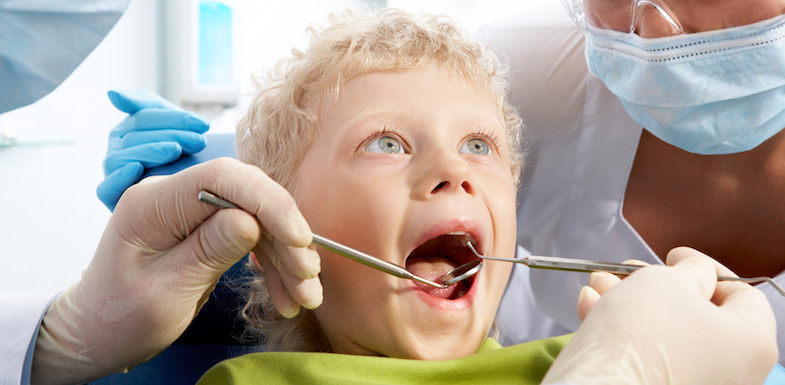For many people, new teeth erupt through the gums without issue. They may require attention after the teeth fully emerge, but most teeth present themselves with just a little redness and soreness. Unfortunately, some patients experience what it known as an eruption cyst.
What is an eruption cyst?
Eruption cysts mainly occur over erupting baby (primary) and permanent teeth. They have a blue tint and are dome-shaped. Some eruption cysts may also range in color from bluish to deep purple or black.
This soft tissue lesion forms on the gum in the area where the erupting tooth is located. Eruptions cysts may be so small as to go unnoticed, but they can be large (in relation to a small child’s mouth), too.
Eruption cyst symptoms
Common symptoms of a dental eruption cyst coincide with many of the same symptoms of tooth eruptions, including:
- Drooling
- Swollen gums
- Fussiness or irritability
- Sleep issues
- Painful ears and cheeks
- Desire to chew on cold or hard surfaces
Rare symptoms include low-grade fever and symptoms that are similar to respiratory infection (e.g., nasal congestion, a feeling of fullness in the ears).
All of the symptoms above may be present with a normal tooth eruption. The hallmark of dental eruption cysts remains the small, discolored swelling located in the soft tissue directly above the erupting tooth.
What causes an eruption cyst?
A tooth eruption cyst occurs when fluid accumulates in the space above the erupting tooth (on the alveolar ridge). If there is blood present in the cyst, the cyst is called an eruption hematoma.
This fluid accumulation can occur due to a variety of factors, including:
- Early caries: Especially for children, early caries (cavities) can be a primary cause of eruption cysts.
- Trauma: Trauma to the mouth can cause accumulation of fluid that may linger. When accompanied by bruising, an eruption hematoma can result.
- Infection: Infection accompanied by swelling can cause fluid to build up.
- Crowding: If there is not enough space for teeth to erupt, the pressure can cause fluid to build up, forming an eruption cyst.
- Inflammation of periapical tissue: Inflammation of the tissue surrounding the tooth’s roots may cause an eruption cyst to form.
Who gets eruption cysts most commonly?
Eruption cysts do seem to demonstrate age and gender bias. Children between the ages of six and nine are most likely to form dental eruption cysts. For no clear reason, eruption cysts occur more frequently on the right side than the left. More males than females report eruption cysts, but pregnant women do also experience eruption cysts more frequently above emerging wisdom teeth.
Dental eruption cysts usually appear above erupting canines and first molars. While in some cases they appear on both sides concurrently, generally they only occur on one side.
How long do eruption cysts last?
The duration of an eruption cyst varies depending on the individual. As a general rule, when children experience eruption cysts in baby teeth, the symptoms begin approximately four days before the tooth erupts. If left to resolve itself, the cyst may begin to recede within three days of the tooth erupting.
If treatment is necessary, the cyst can be resolved much more quickly, with the length of the healing process depending on the treatment (and compliance with post-treatment instructions!).
Are eruption cysts painful?
Generally, the eruption cyst itself is not painful. In fact, some researchers believe that harmless eruption cysts may occur more frequently than suspected but resolve on their own.
If your child does experience an eruption cyst that is accompanied by pain, fever, diarrhea, or other symptoms, it is important to visit the doctor or dentist to rule out other complications.
If an eruption cyst is not resolved when the tooth erupts, it may be a dentigerous cyst. This presents similar symptoms as an eruption cyst, but there are some important distinctions.
- Dentigerous cysts occur most often in patients in their 20s and 30s (not younger children)
- Although they may be harbingers of an erupting molar, they do not resolve when a tooth erupts
- They are slow-growing
- They can affect the alignment of the bite and cause other teeth to shift
- Dentigerous cysts are most often associated with impacted or partially erupted wisdom teeth
Can eruption cysts be prevented?
As noted above, eruption cysts are a relatively common part of erupting teeth. You can’t prevent many of the causes, but proper dental hygiene can help one of the main causes: early caries. Early caries in pediatric dental patients occur when decay is present in erupting teeth. This can be caused by poor dental hygiene or poor nutrition in young children.
Preventing early caries in childhood is as simple as regular doctor’s visits for babies and toddlers, accompanied by the first dental visit when primary teeth emerge. Avoid juices and sugary drinks. This can help prevent eruption cysts caused by early caries.
How can I get help for my eruption cyst in the Phoenix area?
Your dentist will be able to evaluate your eruption cyst and determine if treatment is needed. Many eruptions cysts resolve on their own when the tooth erupts and just need treatment for other symptoms (e.g. mild pain and discomfort). For cysts that do not resolve on their own, surgery may be needed to prevent further infection and complications.
For children, you need a Phoenix area pediatric dentist who knows kids and can gently treat a dental eruption cyst. Even if you require a Phoenix area emergency dentist, we’ve got you covered.
Give AZ Dentist a call to schedule an appointment today.
